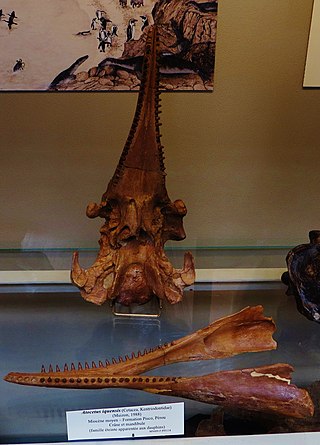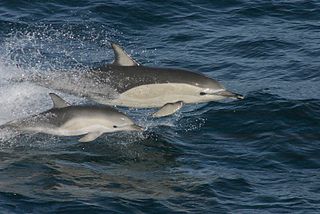
Lipotidae is a family of river dolphins containing the possibly extinct baiji of China and the fossil genus Parapontoporia from the Late Miocene and Pliocene of the Pacific coast of North America. The genus Prolipotes, which is based on a mandible fragment from Neogene coastal deposits in Guangxi, China, has been classified as an extinct relative of the baiji, but is dubious.

Squalodon is an extinct genus of whales of the Oligocene and Miocene epochs, belonging to the family Squalodontidae. Named by Jean-Pierre Sylvestre de Grateloup in 1840, it was originally believed to be an iguanodontid dinosaur but has since been reclassified. The name Squalodon comes from Squalus, a genus of shark. As a result, its name means "shark tooth". Its closest modern relative is the South Asian river dolphin.
Kentriodon is an extinct genus of toothed whale related to modern-day dolphins. Fossils have been found in North America, Europe and Japan. Several species have been described.

Kentriodontidae is an extinct family of odontocete whales related to modern dolphins. The Kentriodontidae lived from the Oligocene to the Pliocene before going extinct.

Livyatan is an extinct genus of macroraptorial sperm whale containing one known species: L. melvillei. The genus name was inspired by the biblical sea monster Leviathan, and the species name by Herman Melville, the author of the famous novel Moby-Dick about a white bull sperm whale. It is mainly known from the Pisco Formation of Peru during the Tortonian stage of the Miocene epoch, about 9.9–8.9 million years ago (mya); however, finds of isolated teeth from other locations such as Chile, Argentina, United States (California), South Africa and Australia imply that either it or a close relative survived into the Pliocene, around 5 mya, and may have had a global presence. It was a member of a group of macroraptorial sperm whales and was probably an apex predator, preying on whales, seals and so forth. Characteristically of raptorial sperm whales, Livyatan had functional, enamel-coated teeth on the upper and lower jaws, as well as several features suitable for hunting large prey.

Acrophyseter is a genus of extinct sperm whales that lived in the Late Miocene off the coast of Peru comprising two species: A. deinodon and A. robustus. It is part of a group of macroraptorial sperm whales which all shared several features for the purpose of hunting large prey, such as deeply-rooted and thick teeth. Acrophyseter measured 4–4.5 metres (13–15 ft), making it the smallest raptorial sperm whale. Because of its short pointed snout, and its strong curved front teeth, it probably fed on the large marine vertebrates of its time, such as seals and other whales.
The St. Marys Formation is a geologic formation in Maryland and Virginia, United States. It preserves fossils dating back to the Miocene Epoch of the Neogene period. It is the youngest Miocene formation present in the Calvert Cliffs and is part of the Chesapeake Group.

Atocetus is an extinct genus of pontoporiid dolphin found in Miocene-age marine deposits in Peru and California.

Albicetus is a genus of stem-sperm whales that lived during the Miocene Epoch, around 15 million years ago, and was discovered in Santa Barbara, California in 1909. It was categorized for decades as belonging to a group of extinct walruses erroneously thought to be sperm whales. It was named Albicetus, meaning "white whale", is a reference to the leviathan in Herman Melville's classic 1851 novel Moby-Dick.
Zarhinocetus is an extinct genus of whale from the Early to Middle Miocene of the eastern North Pacific.
Macrokentriodon is an extinct genus of giant dolphin once assigned to the paraphyletic/polyphyletic family Kentriodontidae. Remains have been found in the late Miocene (Serravallian) Choptank Formation of United States.
Liolithax is an extinct genus of dolphin from the Middle Miocene (Serravallian) Temblor Formation of California.
Xenorophus is a genus of primitive odontocete from late Oligocene (Chattian) marine deposits in South Carolina belonging to Xenorophidae.
Hadrodelphis is an extinct genus of dolphin once assigned to the paraphyletic/polyphyletic family Kentriodontidae. Remains have been found in the middle Miocene (Langhian) Calvert Formation of United States.
Brujadelphis is an extinct genus of river dolphin-like cetaceans of uncertain family placement from the Late Miocene epoch (Serravallian) of present-day Peru. The type species is Brujadelphis ankylorostris, recovered from the Pisco Formation.
Tagicetus is an extinct genus of dolphin belonging to the polyphyletic family Kentriodontidae.

Delphinida is a clade of cetaceans in the parvorder Odontoceti, the toothed whales. It includes all modern oceanic dolphins, porpoises, and their relatives, such as Lipotidae and Iniidae.
Eudelphis is an extinct genus of sperm whale belonging to Physeteroidea that lived in the ancient North Sea basin about 16-11 million years ago, during the middle Miocene (Langhian).
Stenasodelphis is an extinct genus of pontoporiid dolphin from the mid-late Miocene epoch. Its name roughly translates to "the narrow-nosed dolphin." The genus is currently monotypic, containing only the species S. russellae. The specific epithet honors Mrs. Jean Hopper, who discovered the holotype. It was found in material derived from zone 22-23 of St. Marys Formation, which dates to the early Tortonian.










